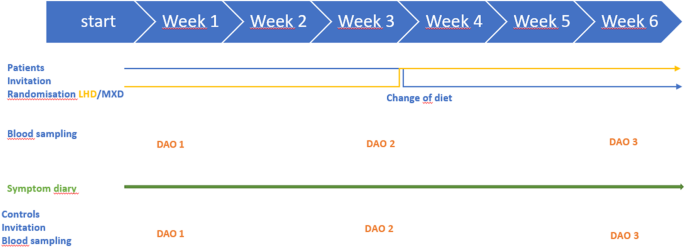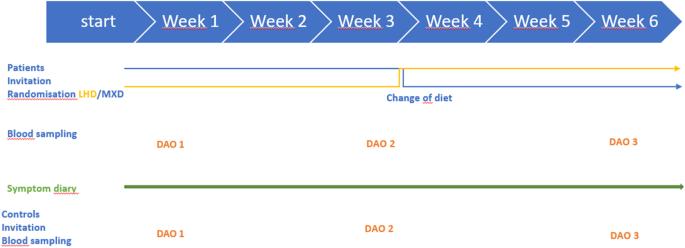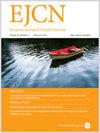组胺不耐受患者在低组胺饮食或普通饮食期间的二胺氧化酶(DAO)测定。
IF 3.6
3区 医学
Q2 NUTRITION & DIETETICS
引用次数: 0
摘要
背景/目的:血清中二胺氧化酶(DAO)浓度的定量分析被认为是评估组胺不耐受(HIT)的一种辅助诊断方法。有关饮食模式对 DAO 水平影响的经验数据有限:在一项采用交叉设计的前瞻性研究中,18名被诊断为HIT的患者被随机分配到低组胺饮食(LHD)或传统混合饮食(MXD)中。在研究开始时和每个饮食阶段结束后测量血清DAO浓度。对照组在不限制饮食的情况下进行类似的 DAO 评估:结果:在实施限制组胺饮食期间,DAO水平的变化与混合(MXD)阶段观察到的变化相比没有明显差异。具体来说,在 18 名患者中,有 10 名患者在接受 LHD 治疗后 DAO 值升高,而其余 8 名患者的 DAO 值要么降低,要么保持不变。在 MXD 阶段,LHD 组 DAO 水平升高的发生率与对照组没有明显差异。此外,在 LHD 阶段,患者的胃肠道和皮肤症状明显减轻:这项前瞻性调查强调了组胺限制饮食和结构化饮食再引入作为一种有效的诊断方法对疑似食物相关组胺过敏症患者的持久效用。值得注意的是,DAO水平的测量似乎只能有限地辨别饮食引起的波动。尽管如此,DAO的动态变化似乎与特定的饮食模式没有明显的联系,这一发现在患者组和对照组中都是一致的。本文章由计算机程序翻译,如有差异,请以英文原文为准。


Measurement of diamine oxidase (DAO) during low-histamine or ordinary diet in patients with histamine intolerance
Quantification of diamine oxidase (DAO) concentrations in serum has been proposed as an adjunctive diagnostic modality for the evaluation of histamine intolerance (HIT). Limited empirical data exist concerning the influence of dietary patterns on DAO levels. In the context of a prospective study employing a crossover design, 18 individuals diagnosed with HIT were randomized to initiate either a low histamine diet (LHD) or a conventional mixed diet (MXD). Serum DAO concentrations were measured at the commencement of the study and following each dietary phase. A control group underwent analogous DAO assessments without imposition of dietary constraints. During the time when a diet restricted in histamine was implemented, noticeable differences in changes in DAO levels did not become apparent when compared to the changes observed during the mixed (MXD) phase. Specifically, among the group, 10 of the 18 patients exhibited elevated DAO values subsequent to the LHD regimen, while the remaining eight displayed either reduced or unchanging DAO levels. The prevalence of elevated DAO levels in the LHD group did not differ significantly from that observed in the control group during the MXD phase. Additionally, during the LHD phase, patients reported a significant reduction in gastrointestinal and cutaneous symptoms. This prospective investigation underscores the enduring utility of a histamine-restricted diet, coupled with structured dietary reintroduction, as an efficacious diagnostic approach for individuals presenting with suspected food-related histamine hypersensitivity. Notably, the measurement of DAO levels appears to furnish only a limited capacity to discern dietary-induced fluctuations. Notwithstanding, the dynamics of DAO alteration do not appear to exhibit a discernible association with specific dietary patterns, a finding consistent across both patient and control groups.
求助全文
通过发布文献求助,成功后即可免费获取论文全文。
去求助
来源期刊
CiteScore
10.60
自引率
2.10%
发文量
189
审稿时长
3-6 weeks
期刊介绍:
The European Journal of Clinical Nutrition (EJCN) is an international, peer-reviewed journal covering all aspects of human and clinical nutrition. The journal welcomes original research, reviews, case reports and brief communications based on clinical, metabolic and epidemiological studies that describe methodologies, mechanisms, associations and benefits of nutritional interventions for clinical disease and health promotion.
Topics of interest include but are not limited to:
Nutrition and Health (including climate and ecological aspects)
Metabolism & Metabolomics
Genomics and personalized strategies in nutrition
Nutrition during the early life cycle
Health issues and nutrition in the elderly
Phenotyping in clinical nutrition
Nutrition in acute and chronic diseases
The double burden of ''malnutrition'': Under-nutrition and Obesity
Prevention of Non Communicable Diseases (NCD)

 求助内容:
求助内容: 应助结果提醒方式:
应助结果提醒方式:


